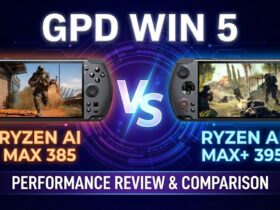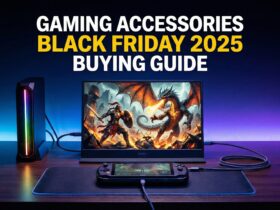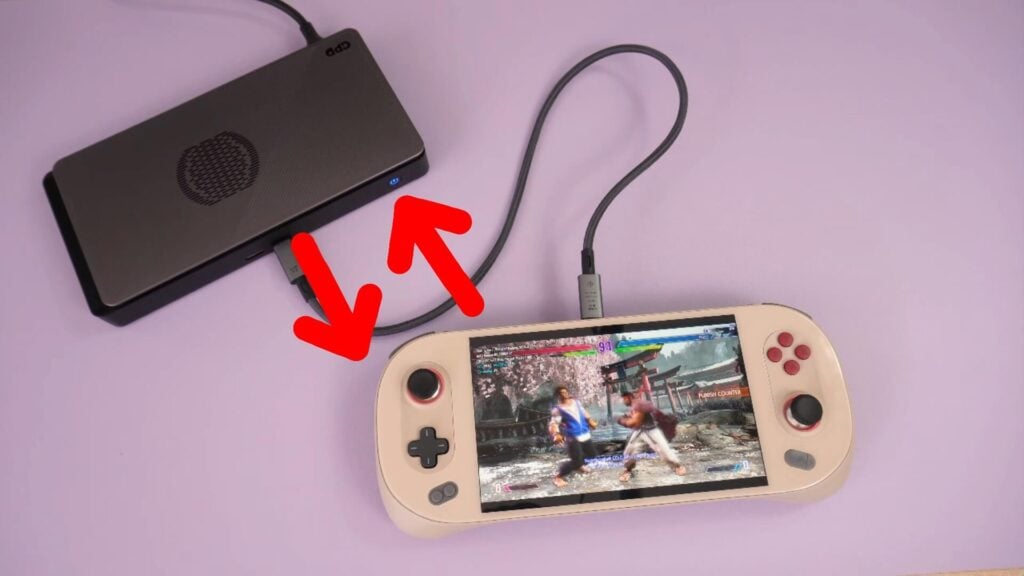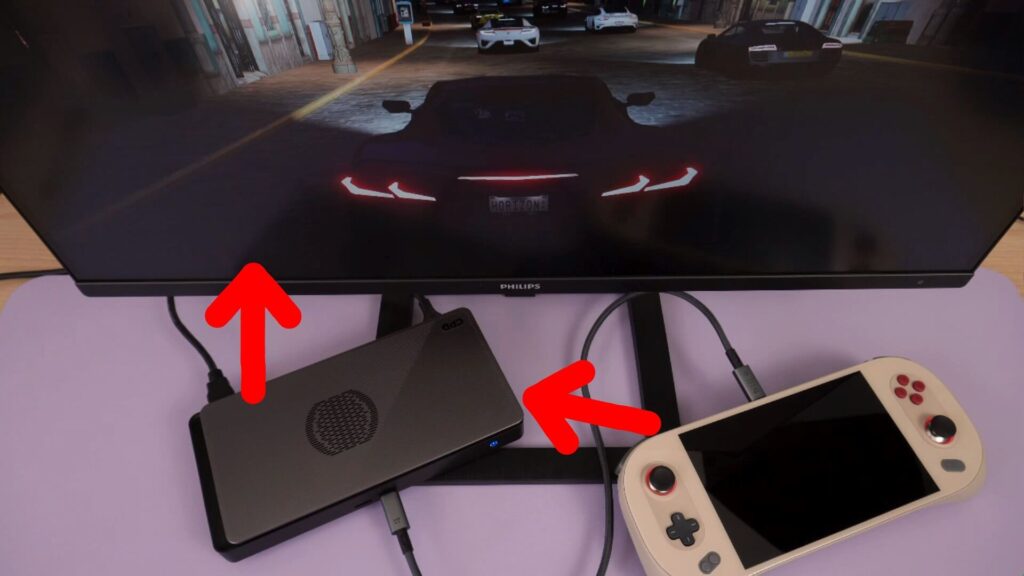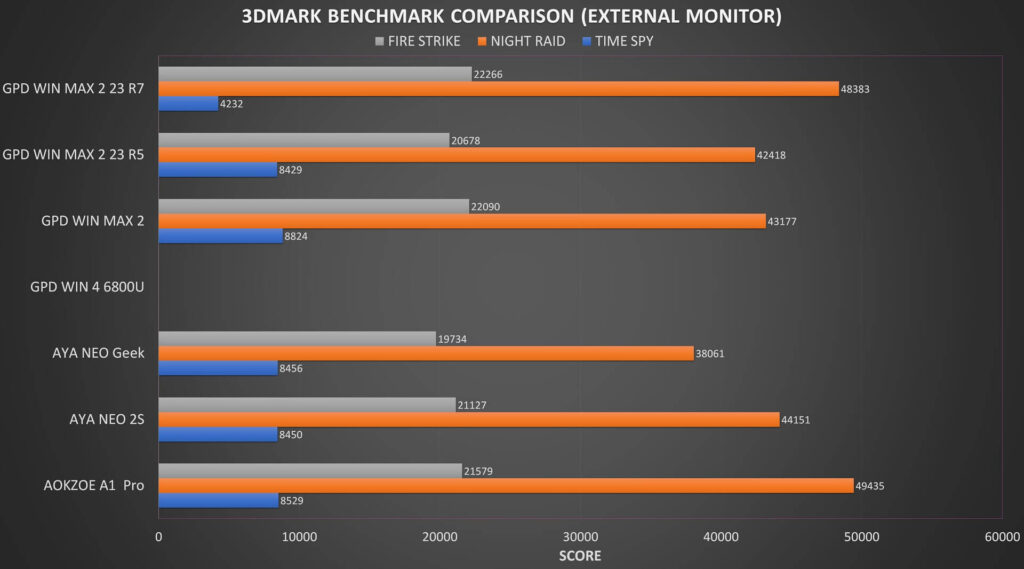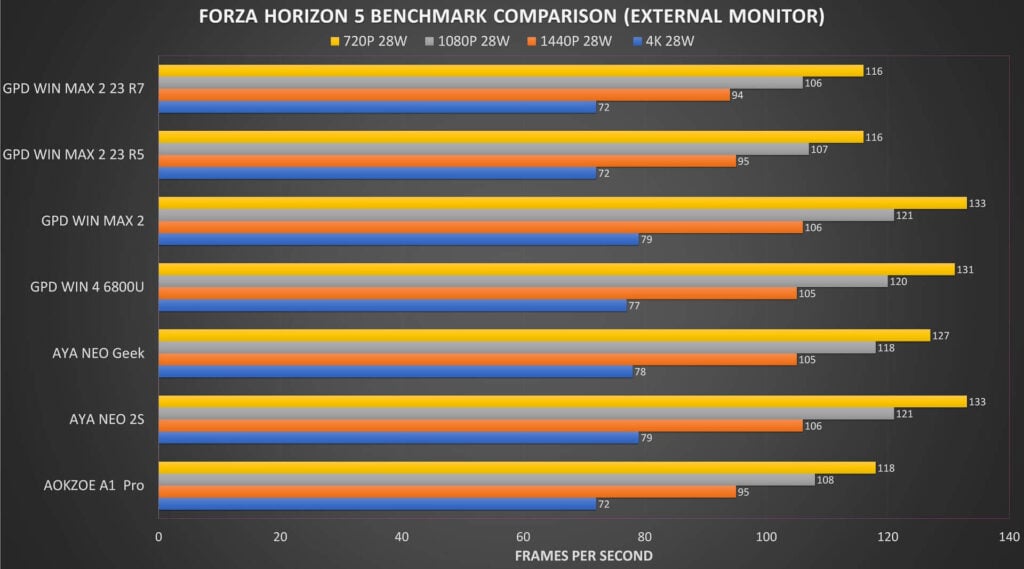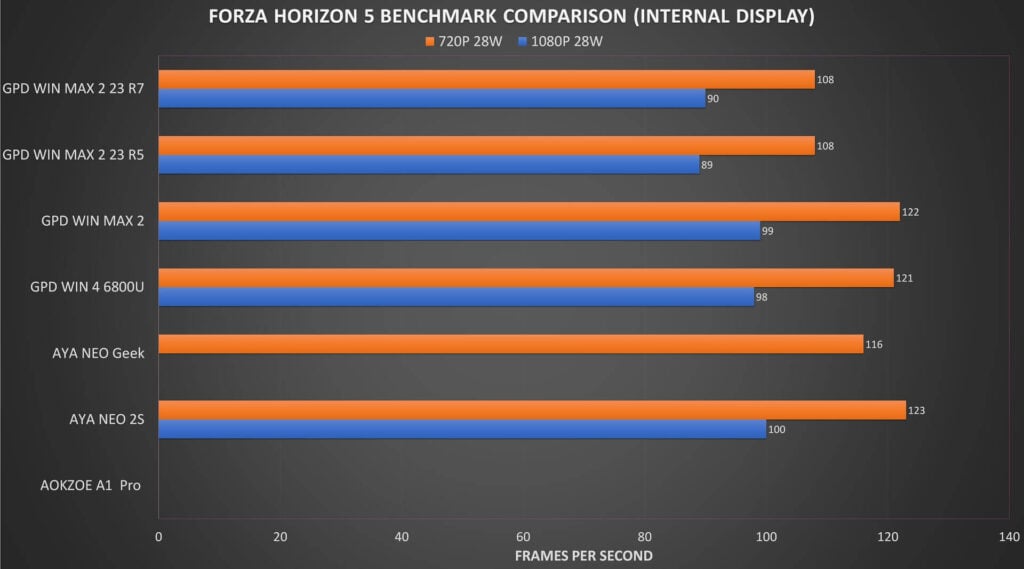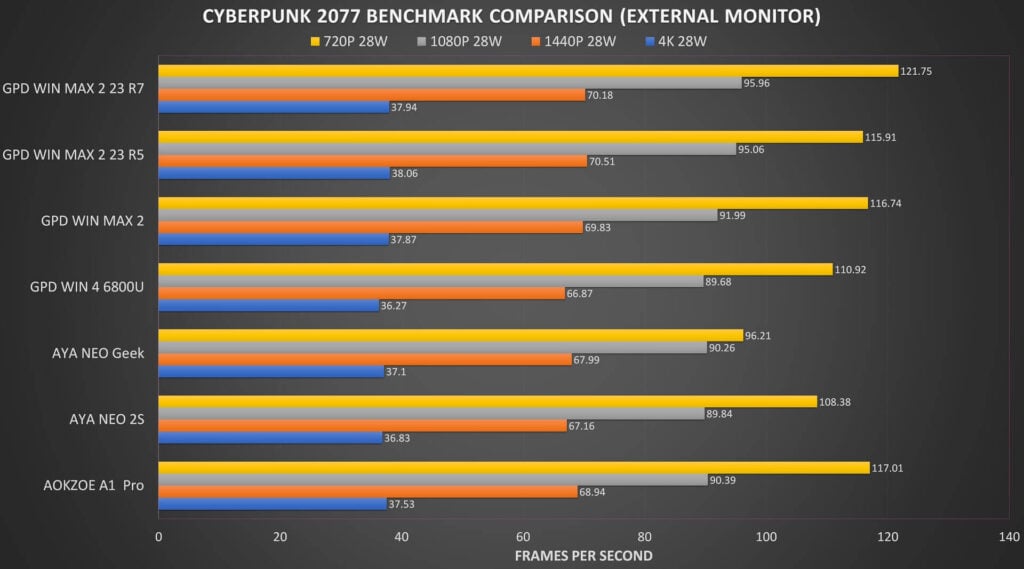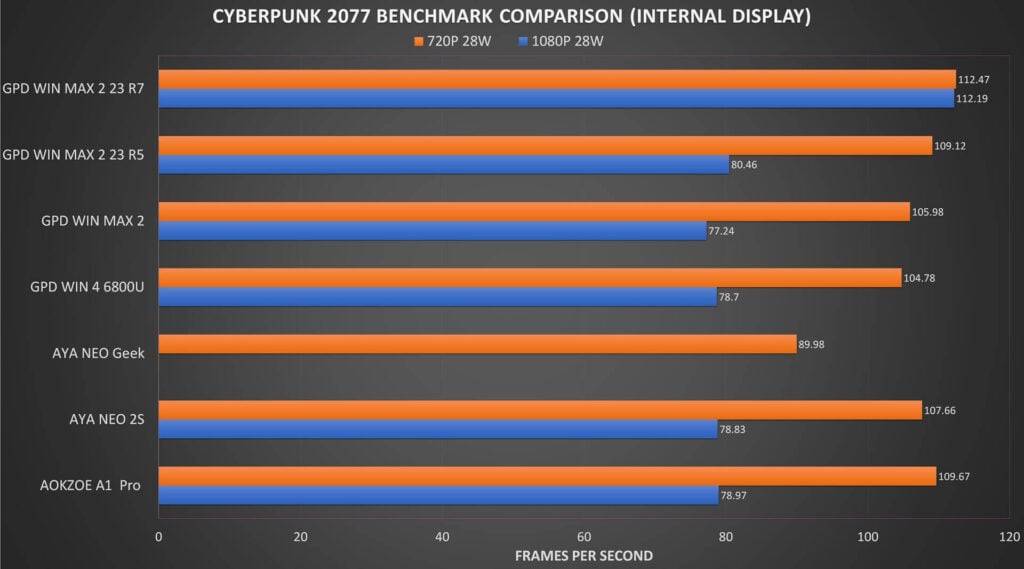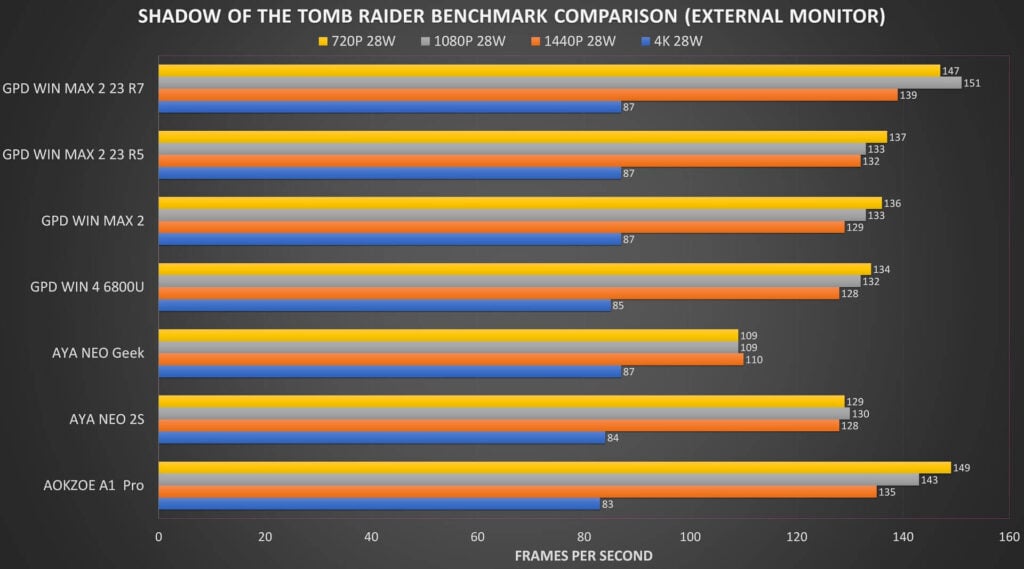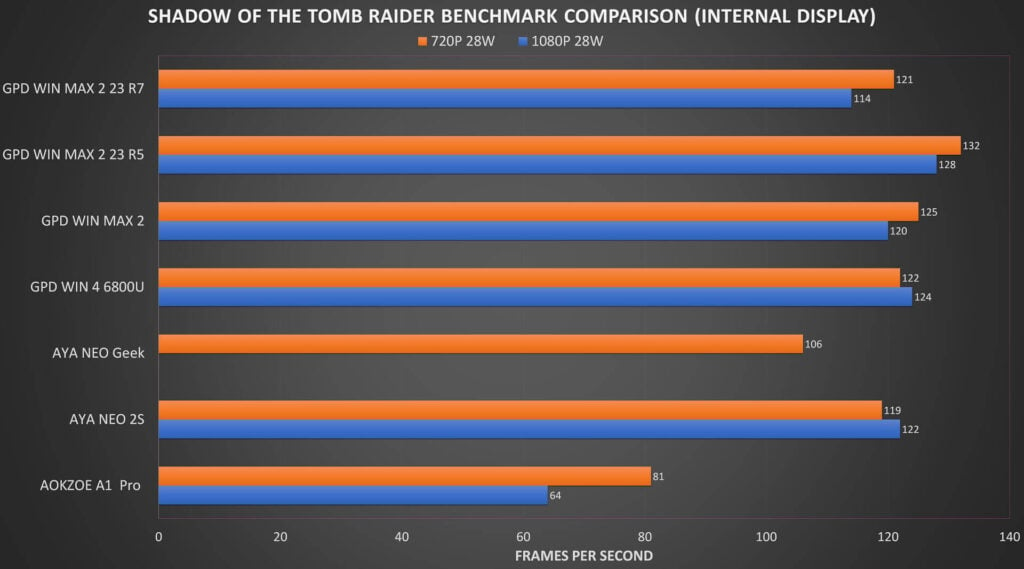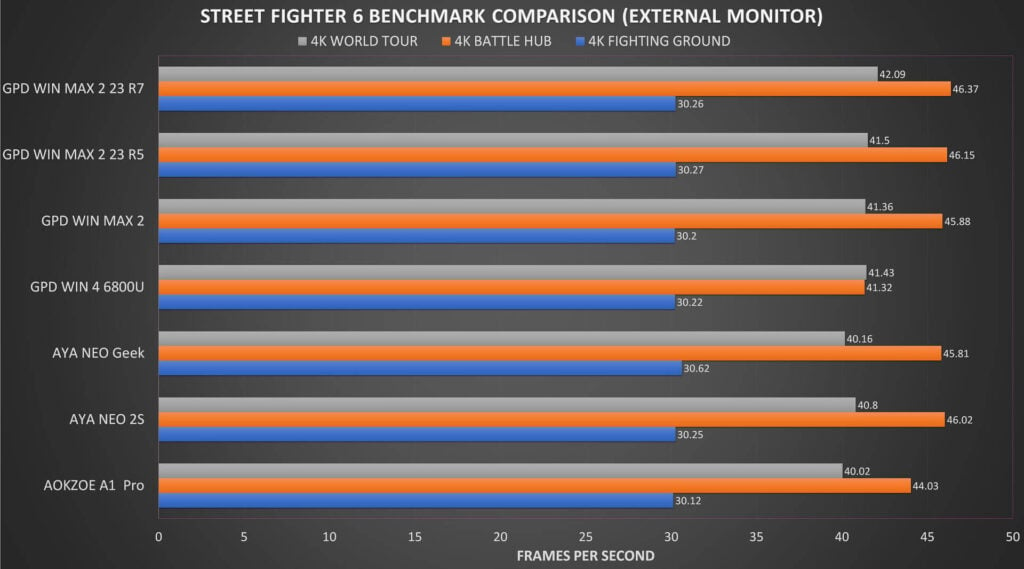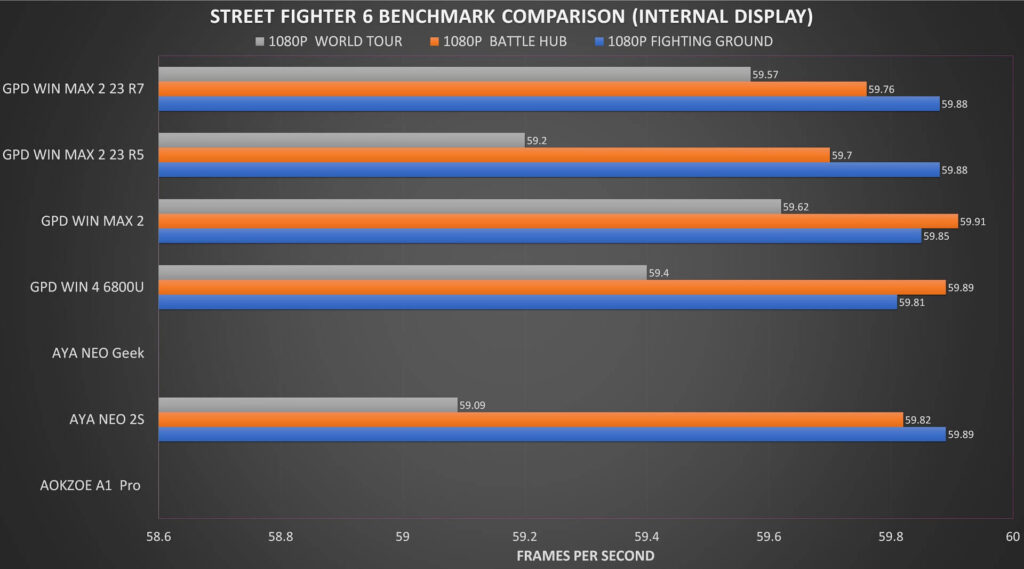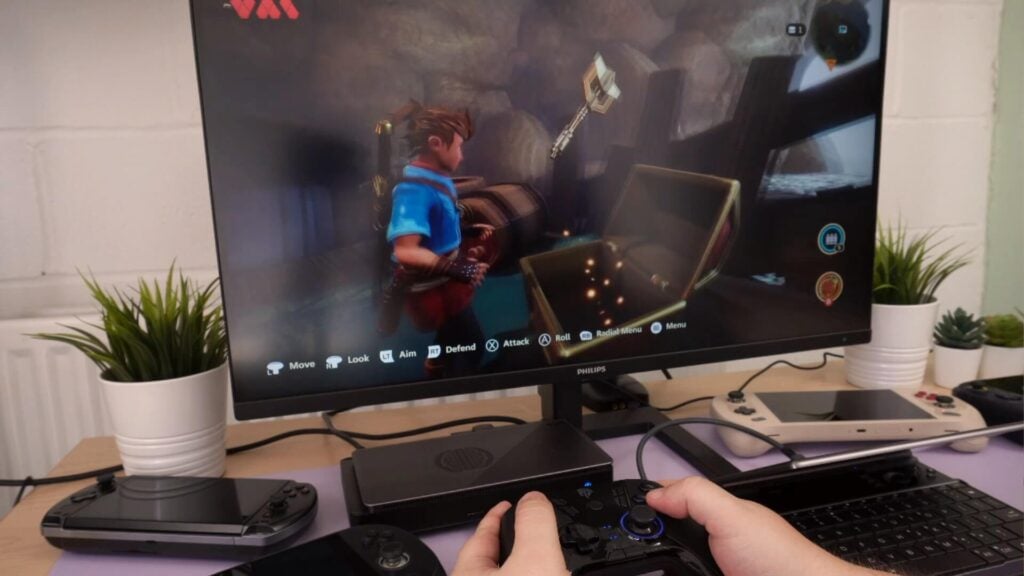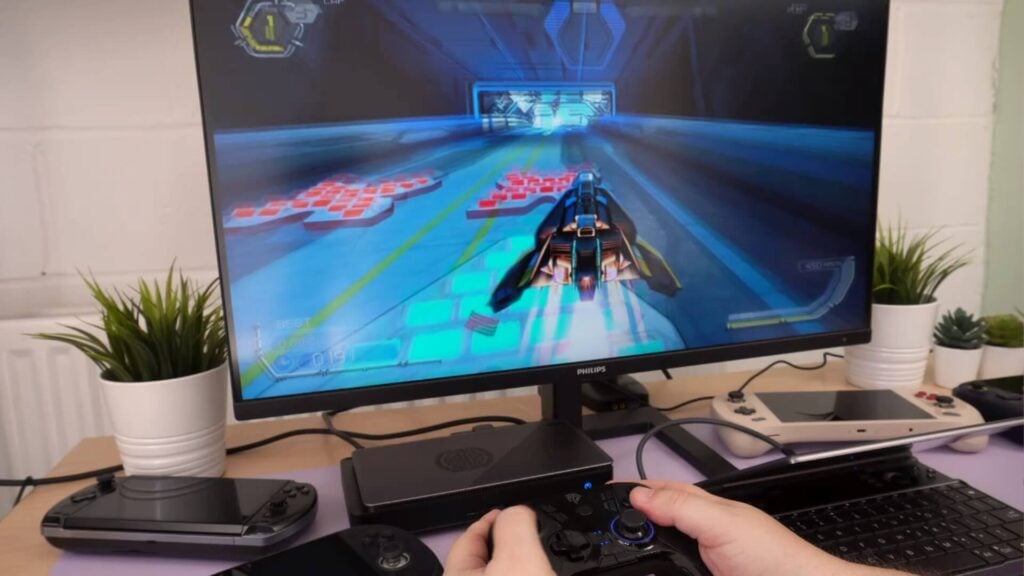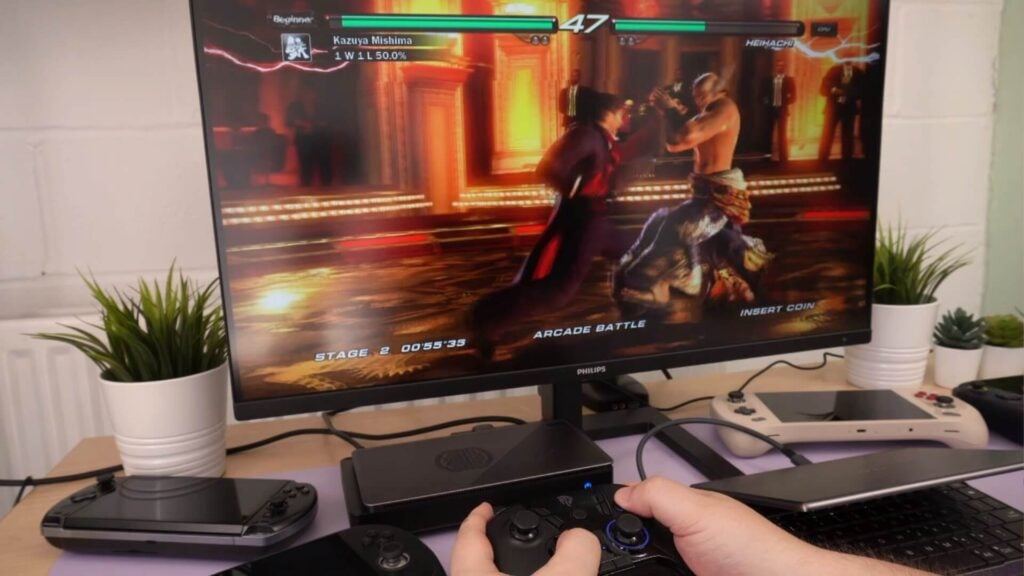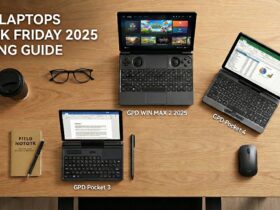De officielle AMD-drivere til 7000-seriens processorer blev frigivet for et par uger siden, og vi kan nu opdatere vores håndholdte enheder til at bruge de samme drivere. Det betyder, at vi nu kan udføre GPD G1 eGPU docking station-benchmarks og få en bedre idé om, hvordan de hver især præsterer over USB 4. Dette er ikke en anmeldelse, men du kan finde vores fulde anmeldelse af GPD G1 eGPU-dockingstationen her.
GPD G1 eGPU-dockingstation benchmarks video
Benchmark-oplysninger
Så før vi går i gang med benchmarks, vil jeg kort gennemgå, hvad vi gjorde. Vi bruger AMD v23.7.2-driverne på alle håndholdte enheder. Dette er de første officielle AMD-drivere, der er kompatible med 7000-seriens CPU'er, og vi så en række forbedringer og forringelser i stabilitet og ydeevne sammenlignet med beta-driverne. Mere om dette efter benchmark-resultaterne.
Vi tester med GPD WIN MAX 2 2023 Ryzen 5- og 7-modeller, som begge understøtter Oculink og USB 4. Der er også AOK ZOE A1 Pro og AYA NEO 2S, som alle har 7840U-processoren. Vi vil også teste GPD WIN 4, GPD WIN MAX 2 og AYA NEO Geek, som har den tidligere generation af 6800U-processorer. Alle disse mangler en Oculink-port, men har USB 4.0-understøttelse.
Hvorfor benchmarke interne og eksterne skærme?
Vi vil benchmarke dem med deres interne display og output til en ekstern skærm via GPD G1 eGPU-dockingstationen. Hvorfor begge skærme? Dette er for at se, hvordan USB 4-båndbredden påvirker ydeevnen. Når du bruger en intern skærm, sendes dataene fra den håndholdte til G1 og derefter tilbage til den håndholdte for at blive vist på den interne skærm.
Det kræver dobbelt så meget båndbredde gennem USB 4-kablet, som det ville gøre at sende data fra den håndholdte til GPD G1 eGPU-dockingstationen og derefter direkte ud til en ekstern skærm. Brug af interne skærme kan resultere i flaskehalse og sænke eGPU‚ens ydeevne.
Oculink er en metode til dataoverførsel med højere båndbredde end USB 4.0, op til 64 mod 40 Gbps. Det betyder, at der kan overføres flere data, hvilket resulterer i færre flaskehalse og optimal ydeevne. Vi vil undersøge og sammenligne Oculinks ydeevne i en fremtidig artikel.
Hvilke benchmarks køres der?
For alle håndholdte kører vi med 28W TDP, og vi bruger 4K, 1440P, 1080P og 720P på en ekstern 4K-skærm. Til interne skærme på alle andre end AYA NEO Geek bruger vi 1080P og 720P, uanset hvilke opløsninger de håndholdte understøtter. AYA NEO Geek har en intern skærmopløsning på 800P, så der er ingen 1080P-test til denne model. Vi holder dem i samme opløsning, så vi kan få en mere præcis sammenligning af ydeevnen.
Benchmarks
3DMark
Vi starter GPD G1 eGPU-dockingstationens benchmarks med 3DMark. Vi tester kun med en ekstern skærm til 3DMark, da den kører med forskellige opløsninger på interne skærme.
Af hensyn til gennemsigtigheden havde vi et par problemer med at køre 3DMark-benchmarks med G1, som regel tilfældige nedbrud eller fastfrysninger. Jeg tror, det skyldes brugen af en ekstern GPU mere end noget andet, da det skete på tværs af et par forskellige enheder. Vi gentog GPD WIN MAX 2 2023 Ryzen 7 Time Spy-benchmarken et par gange, og den ville ikke gå højere end 4.232. Vi aner ikke hvorfor, der er et underligt problem med denne driverversion. Det samme med GPD WIN 4, den frøs eller crashede tilfældigt i alle tre tests.
AOKZOE A1 Pro kom lige akkurat ud på toppen her baseret på gennemsnit.
Forza Horizon 5
Vi starter gaming GPD G1 eGPU docking station benchmarks med Forza Horizon 5 på meget lave grafikindstillinger. AMD's CPU'er og GPU'er er optimeret til at fungere godt i dette spil, så det er ideelt som test.
Ved brug af den eksterne skærm får vi ved 4K fra 72 op til 79 FPS på tværs af enhederne. Og lignende mønstre for 1440P, 1080P og 720P. AYA NEO 2S og den originale GPD WIN MAX 2 indtager førstepladsen her med de samme frame rates, hvilket ikke er dårligt, når man tænker på, at de er CPU'er i henholdsvis 6000- og 7000-serien.
På den interne skærm ville AOKZOE A1 pro ikke gennemføre nogen benchmarks. Vi tror, det er et problem med USB-båndbredden, da den bare crasher tilbage til skrivebordet på må og få. AYA NEO 2S tager lige føringen med WIN MAX 2 og WIN 4 meget tæt efter.
Cyberpunk 2077
Vores næste benchmark er Cyberpunk. Vi bruger de laveste grafikindstillinger uden opskalering.
På den eksterne skærm ser vi meget ens resultater ved 4K og 1440P, med en vis variation ved 1080P og 720P GPD WIN MAX 2 2023 Ryzen 7 tager føringen her.
På den interne skærm klarer Ryzen 7 sig igen meget godt med et par ekstra frames over de andre, med sin Ryzen 5-bror på en klar andenplads. Der er et par frames forskel i forhold til de andre, men ellers er der ikke noget at bemærke.
Skyggen af Tomb Raider
Det næste er Shadow of the Tomb Raider, der kører med de laveste grafikindstillinger. På trods af spillets alder er det stadig meget krævende.
På den eksterne skærm falder AYA NEO GEEK bagud ved 1080P og derover, det kan være et køleproblem her. MAX 2 23 Ryzen 7 og A1 Pro får i gennemsnit meget gode resultater i GPD G1 eGPU docking station benchmarks.
På den interne skærm ser vi en vis forskel i forhold til den eksterne skærm. AOKZOE A1 Pro lider igen af mulige båndbreddeproblemer med et massivt fald i ydeevnen. GPD WIN MAX 2 Ryzen 5 klarer sig faktisk en smule bedre end Ryzen 7 i dette benchmark, hvilket var overraskende.
Street Fighter 6
Noget nyere er Street Fighter 6. Vi kører med 4K på de højeste grafikindstillinger for at se, hvor godt alting fungerer under store belastninger.
På den eksterne skærm får vi meget ens resultater på tværs af de fleste håndholdte med bogstaveligt talt et billede eller to i forskel. Der måtte dog være en undtagelse, GPD WIN 4 oplevede et fald i ydeevnen på 2. og 3. del af GPD G1 eGPU-dockingstation-benchmarks.
På den interne skærm ved 1080P viser søjlediagrammet meget lille forskel mellem de håndholdte, da de alle kører med 60 billeder i sekundet. AOKZOE A1 Pro ville ikke spille pænt med tilfældige nedbrud tilbage til skrivebordet. AYA NEO Geek ville sandsynligvis også kunne køre ved 60FPS, men vi er begrænset til 800P-opløsning på denne håndholdte.
Sammenfatning af benchmarks for GPD G1 eGPU-dockingstation
Vi kan se på benchmarks, at AMD 7000-seriens drivere stadig er meget ustabile og underpræsterer under visse forhold. Vi så nogle forskelle fra de benchmarks af beta-drivere, vi lavede i vores hovedanmeldelse. De var på nogle måder mere effektive, men ikke så stabile. Og med de nye officielle drivere, der ofte har lavere ydeevne, men er lidt mere stabile. På nogle benchmarks eller enheder vil det så være omvendt! AMD-drivere er lidt af et rod lige nu til 7000-serien!
Vi forventer, at fremtidige versioner vil forbedre både stabilitet og ydeevne for 7000-seriens håndholdte enheder. Husk på, at 6800U er en tidligere generation af processorer, der havde lignende problemer, da de først udkom, og siden har haft tid til at modne driverne, så det burde være det samme for 7000-serien med tiden.
Denne artikel sammenligner USB 4-ydelsen med GPD G1 eGPU-dockingstationen på tværs af en række nuværende og tidligere generationer af håndholdte computere. Vi ser sammenlignelig performance i GPU-krævende spil på begge generationer af processorer. Det er fantastisk, da det kan puste nyt liv i ældre håndholdte, der kæmper for GPU-intensive spil. I nogle tilfælde så vi, at 6800U havde højere score end 7840U CPU'erne. Men husk på, at nyere modeller kan understøtte Oculink, og det er her, vi vil se en generel præstationsforøgelse.
Afsluttende tanker
GPD G1 eGPU-dockingstationen er et fremragende stykke udstyr, som i øjeblikket er lidt skuffet over dårlig AMD-driverunderstøttelse. Disse benchmarks presser den til det yderste, og den klarer det meget godt, forudsat at den håndholdte enhed kan følge med, i modsætning til AOKZOE A1 Pro. Som vi så i vores anmeldelse af GPD G1 eGPU-dockingstationen, kan du, afhængigt af spillets krav, normalt spille spil ved 1440P med anstændige grafikindstillinger eller 4K med lavere indstillinger.
GPD G1 er bestemt værd at overveje, hvis du har en håndholdt model i 6000-serien og ikke ønsker at opgradere til en nyere model. Spil vil takke dig for det massive boost i GPU-ydeevne.
Hvis du har den nyeste 7000-serie, vil du selvfølgelig se det massive løft i ydeevnen. Med tiden vil vi måske endda se hurtigere ydeevne, efterhånden som driverne forbedres. GPD G1 er stadig et godt valg til denne generation, men det kræver lidt tålmodighed at få det bedste ud af den.
Som vi nævnte, er GPD G1 eGPU-dockingstationen et fremragende stykke udstyr, du kan være ude og spille på din håndholdte, og derhjemme kan du docke den med en trådløs controller for at spille på storskærm med højere ydeevne, opløsning og grafik.
Hvor kan man købe GPD G1 eGPU-dockingstationen?
Du kan læse mere om og bestille GPD G1 eGPU-dockingstationen her. Og glem ikke, at du kan købe alle de håndholdte gaming-pc‛ er, der præsenteres i dag, inklusive forudbestillinger af den nye GPD WIN 4 2023-model med Oculink-port og 7840U CPU.
Hvad synes du om GPD G1 eGPU-dockingstationens benchmarks? Vil du gerne se andre tests eller artikler om det? Fortæl os det i kommentarerne!
[azp_custom_product id=‟39″]



